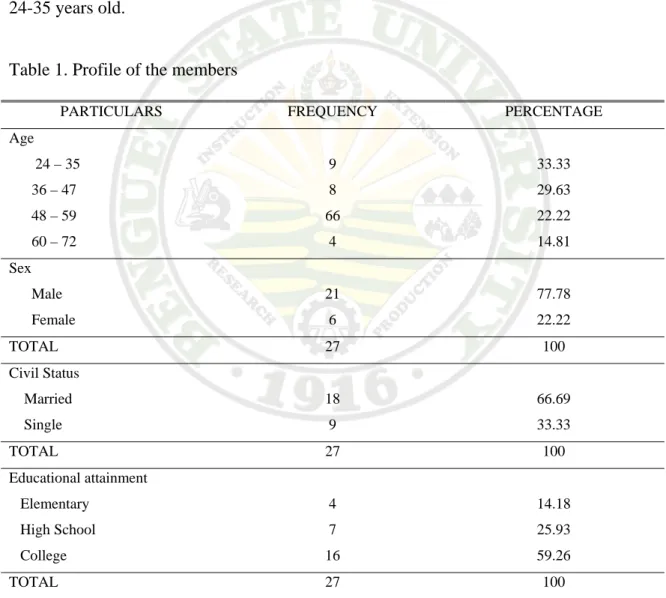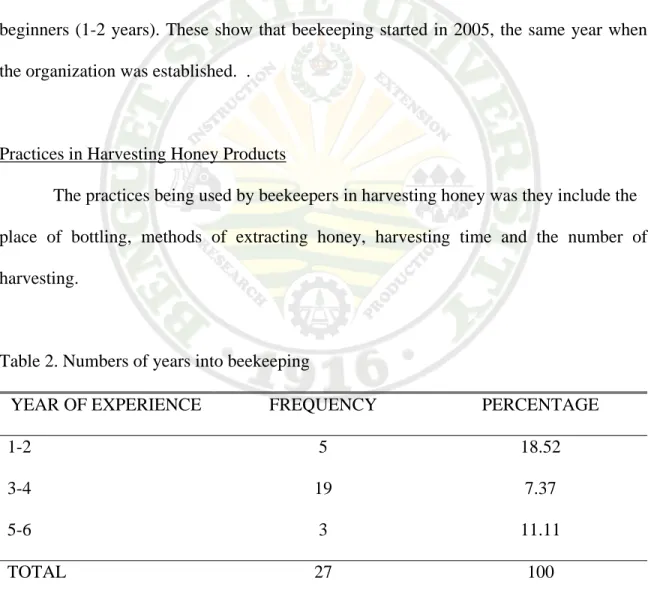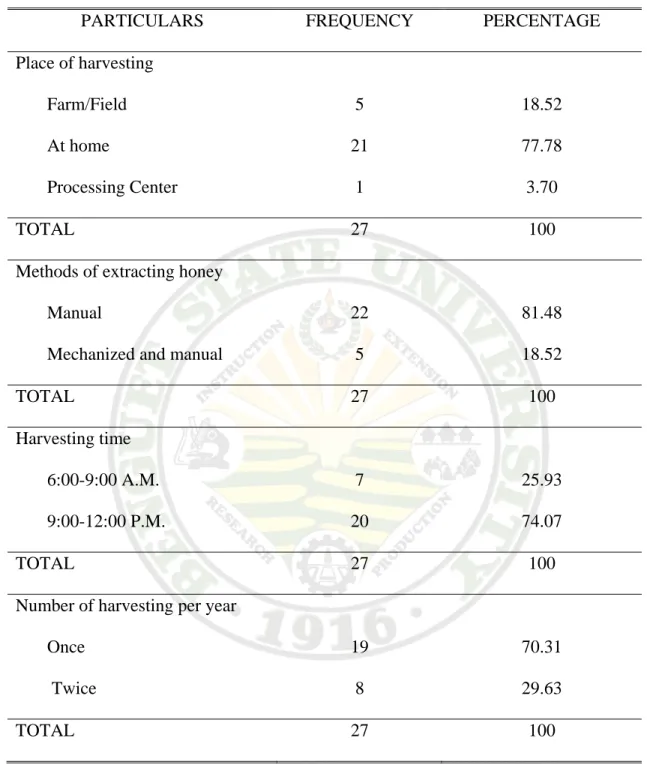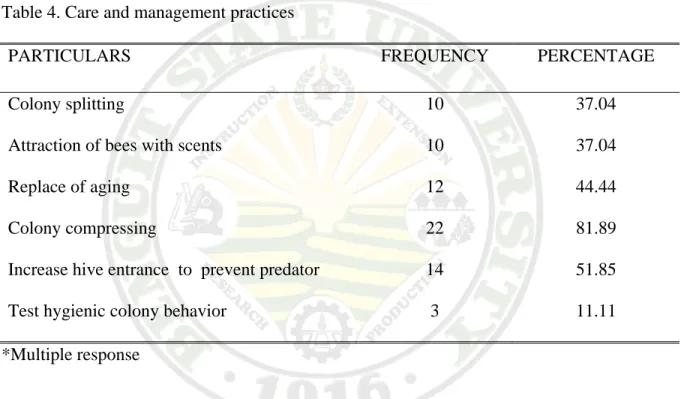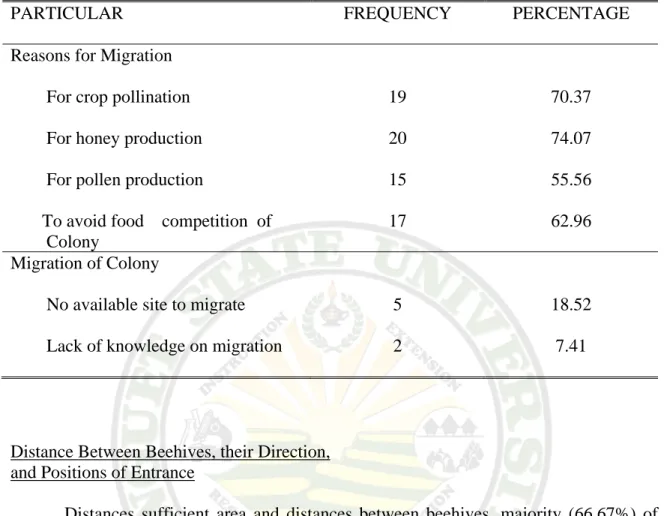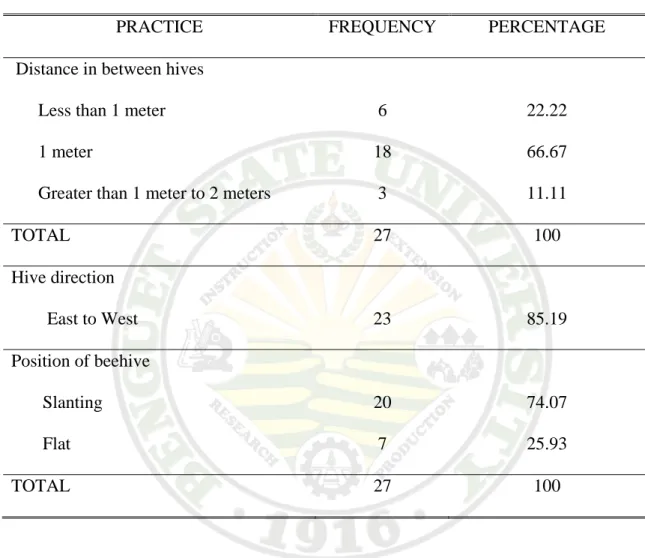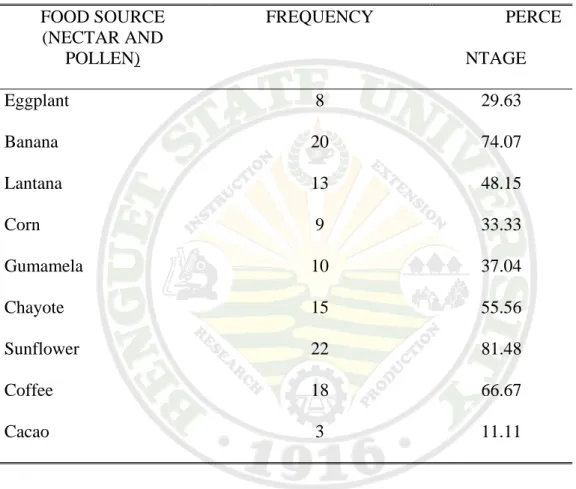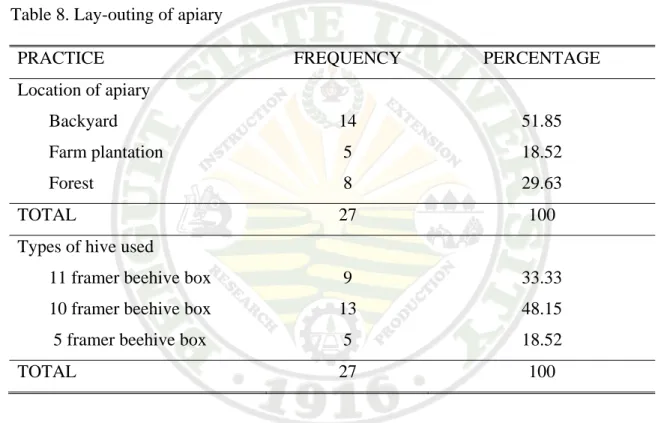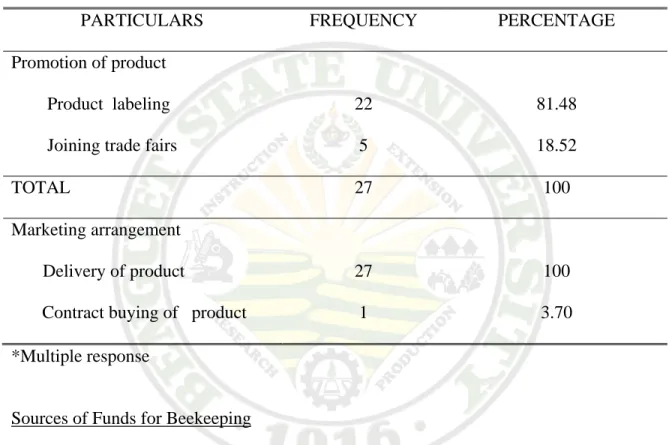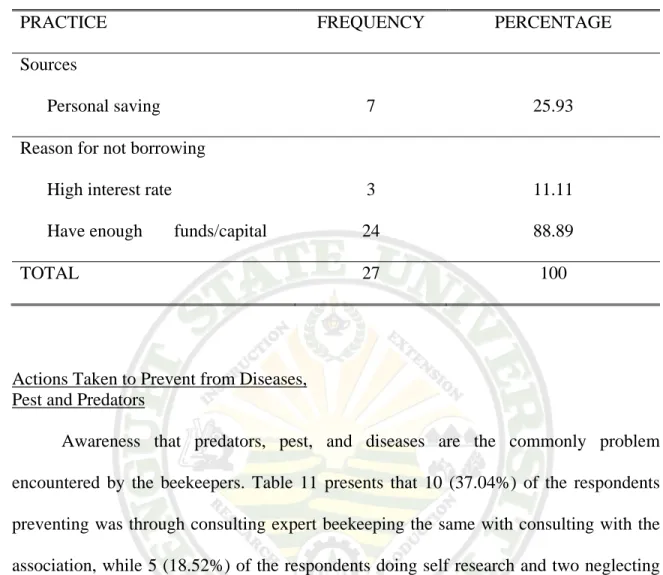JUDILYN M.DAGDAG. APRIL 2008. Beekeeping Practices by the Members of the Gold Honey Organization in Kapangan, Benguet .Benguet State University, La Trinidad, Benguet.
Adviser: Prof: Andrew K. Del-ong, BSc
ABSTRACT
This study was conducted in the different barangays of Kapangan Benguet. This study aimed to determine the beekeeping practices for honey production, specifically to determine the following:1) to know the profile of beekeeping, 2) management practices on beekeeping, 3) care and management of bee colony, 4) preparation and lay-outing of apiary site, 5) promotion of honey product, 6) source of capital in honey bee production.
The respondents were the 27 beekeepers who are members of the Kapangan Gold Honey Beekeepers Organization (KAGOHBO). Most of the apiaries are within or near the backyard for easy monitoring on the condition of the colonies of any presence of disease, pest and predators. Most of them used pure manual operation for extracting honey.
Members preferred one meter distance in-between beehives. Entrance of the beehives should be positioned east to west direction for the entrance of the colonies to be easily stricken by the sun. During summer the beehives is flat and slanting position during the rainy season. Members avoid transporting the colonies from nine to twelve
from possible stress caused by heat in the day.
Members use 5, 10 and 11 framer beehive box. The source of forage substances (propilis,nectar,pollen) are from wild sunflower, banana flower, coffee tree, chayote vine, lantana, gumamela flower, corn, eggplant, beans, tomato, cacao and cucumber.
Most of the members prefer to use bottle in packing honey. All of the members used their personal savings for their beekeeping business rather than borrowing because of high interest rate.
Beekeepers practiced free delivery of the product to the customers. All the members produces liquid form of honey and sells it by bottle. Members promote their products by joining trade fairs and labeling their honey product properly.
The main problem of the beekeepers for honey bee production is disease and predators. The members consult expert beekeepers, in the locality and also consult other members/beekeepers of the organization or do self research.
Factors affecting beekeeping operation were lack of food source, lack of wind breaks on apiaries against typhoon and coldness and prone of forage bees to pesticide spray and disturbance of human and animals.
Agencies/organizations sponsoring the project should provide more trainings or technical assistance to the beekeepers especially on the following: care and management, disease management, grading and improved packaging and labeling to make the product competitive.
Financial assistance should be provided at a minimal interest, affordable by the beekeepers.
Page
Bibliography . . . i
Abstract . . . i
Table of Contents . . . iii
INTRODUCTION Rationale of the Study . . . 1
Statement of the Problem . . . . . . 2
Objectives of the Study . . . 3
Significance of the Study . . . 3
Scope and Limitation . . . 4
REVIEW OF LITERATURE Honey Production as a Modern Occupation . . . 5
Staring a Good Apiary as Requirements . . . 6
Anxiety and Management of Colonies . . . 6
Honey Harvesting and Processing . . . 7
Bee Business . . . 9
Hindrance to Success in Beekeeping . . . 9
Beekeeping and It’s Uses . . . 9
Trainings and Extension Services Requirement of Beekeepers . . . 10
Definition of Terms . . . 10
Locale and Time of the Study . . . 13
Respondents of the Study . . . 13
Research Instrument . . . 13
Data Collection . . . 13
Data Analysis . . . . . . 14
RESULTS AND DISCUSSION Profile of the Members . . . 15
Membership to Organization . . . 16
Number of Years into Beekeeping . . . 16
Practices in Harvesting Honey Products . . . 16
Colony Migration . . . 19
Distance Between Beehives, their Directions, and Positions of Entrance . . . . . . 20
Plant Producing Pollen and Nectar Substance . . . .. . . 21
Apiary Sites and Preferred Sizes of Beehives . . . 22
Market Promotion of Honeybee Products . . . 23
Marketing Practices . . . 24
Sources of Funds for Beekeeping . . . 24
Actions Taken to Prevent from Diseases, Pest and Predators . . . 25
Factors Affecting Beekeeping . . .
25
Summary . . . 27
Conclusions . . . 28
Recommendations . . . 29
LITERATURE CITED . . . 30
APPENDIX A . . . 31
Rationale of the Study
Beekeeping is an important component of present strategies for sustainable agriculture and integrated rural development program. Aside from its economic contributions, it also contributes to ecological balance. This venture is viewed as a potential industry (small scale industry) for development because it can provide
employment to the people especially in the rural communities. However, from a practical stand point, beekeeping can be a dependable agricultural occupation only
when the beekeeper has the technical know how in beekeeping.
The profitability of honeybee culture as a business depends partly on the behaviors of the beekeeper and partly on nature. Inadequate skills in training techniques, ineffective methods employed on beekeeping, limited financing, inadequate knowledge on post harvest handling and processing, and limited knowledge on proper marketing management of products are some factors that may affect the profitability of honey production.
In 2005, the Local Government Unit (LGU) of Kapangan, Benguet, thru the Municipal Agriculture Office implemented a joint project with Saint Louis University (SLU) in Baguio City, and the Benguet State University (BSU), on beekeeping. This project is supported by the Philippine Inter University Cooperation (PIUC). The project, dispersed bee colony to interested farmers, and provided technical assistance to the beekeepers. The project aimed to provide additional livelihood or income to the farmers.
It also aimed to eliminate the “green gold” (marijuana production) livelihood of some
people in the area. Beside, bees are beneficial insects to the farmers, because they help in pollination of plants. Currently, LGU of Kapangan is maintaining 32 honeybee colonies under the Municipal Agriculture Office. This served as a techno training venue for the farmers.
The municipality of Kapangan has more than two years experience on beekeeping. For easy monitoring and assistance especially on technical the beekeepers were organized into an association. There were twenty-seven members of the organization which was named “Golden Honey Organization”.
Bee diseases are one of the main problems for beekeepers. The presence of diseases depends on the number of colonies kept and is often encountered when apiary is not properly managed.
Statement of the Problem
This research was conducted in Kapangan Benguet to answer the following questions related to the beekeepers.
1. Who are the members of the Gold Honey Organization in Kapangan, Benguet?
2. What are the beekeeping practices for honey production by beekeepers in Kapangan, Benguet?
3. What are their harvesting practices?
4. What form of honey do they produce and how they promote and market said products?
5. What are the sources of additional funds used in the operations?
6. What are the hindrances they are encountering in beekeeping and how do they solve these problems?
Objectives of the Study
The general objectives of this study were to find out the beekeeping practices on honey production in Kapangan, Benguet.
Specifically, it aimed to:
1. Know, who are the members of the Gold Honey Organization in Kapangan, Benguet.
2. Determine the production practices of beekeepers specifically on:
a. Care and management of colonies b. Preparation and lay outing of apiaries 3. Harvesting practices of honey produced?
4. Identify the form of the produced and the system of promotion and marketing practices of the beekeepers.
5. Identify the sources of additional funds used in beekeeping operations.
6. Identify the hindrances to the honey production and how to prevent from diseases.
Significance of the Study
The result of this study would provide information that are necessary and useful to assess the condition of the beekeeping industry, to help the policy makers, project
implementers, cooperatives and associations to formulate plans for the development of the backyard honey production activities of small producers.
Scope and Limitation
This study was limited to the members of the Gold Honey Organization in Kapangan Benguet. It focused on the members’ production, financial management, and marketing practices.
It includes the demographic profile of beekeepers, form of honey produced for market, available technology used in grading and sorting of honey produced and common problems encountered to bee producers. The source of additional funds used in the operation and the budgeting and farm record keeping practices of members.
REVIEW OF LITERATURE
Honey Production as a Modern Occupation
Beekeeping is a traditional household activity that, with support of modern techniques can improve the productivity of crops, fruits and vegetable through cross- pollination. It also helps in the preservation of the natural eco system through cross- pollination of forest plants
The introduction and modernization of beekeeping in tropical Asia, are being made like in Indonesia, Malaysia, Nepal, Bangladesh, Sri lanka,Thailand and Philippines (Matsuka et al.,1998).
According to Ananayo (1989), the introduction of culturing the honeybee in the Cordillera region is widely used to increase production specifically on honey. Nowadays, this specie is commercialized and gaining popularity and support among local beekeepers of Baguio and Benguet considering that it can adapt in the municipality’s geographical locations and also suit on its environment conditions that favor nectar and pollen producing plants in which bloom almost year round.
There are certain plants producing nectars and pollen substances that bees forage.
These plants are found in the Cordillera region, which is considered as the best and most promising area for the culture of honeybees. The report of the Ecosystem Report Research and Development Service (ERDS) in 1989 said these plants are eucalyptus, Calliandra, lithocarpus weeping willow, kakawate, golden shower anchoan dilao, duhat molave.In addition to that he also identified other plants available in the are as wild sunflower, acacia, narra, coffee citrus, mango, coconut, corn, chayote, and other weeds.
Bees are insects of Hymenoptera, which feed on pollen and nectar. They constitute a group of about 20,000 species through out the world, known as family. All honeybee species are asocial insects, meaning they engage in favorable social activity like man. As an inherited behavior characteristic all honeybee colonies tend to rear their brood and store a certain amount of honey and pollen as their food reserve by secreting the workers wax glands and store honey in the upper part of the comb. Beneath it are rows of pollen-storage cells, workers broad cells, and drones cells are normally built at the lower edge of the comb. The quality of food stored depends upon several, including the seasonal availability of forage, the workers population, and the colony’s natural site of construction.
Starting a Good Apiary as Requirements
Starting a colony needs initial amount of Php 50,000.00 as working capital. Best time to start is during summer because flowers are in bloom for sufficient source of nectar and pollen. Bee colony should be procured from reliable source and it should be free from mite’s disease (Wal, 1996).
Anxiety and Management of Colonies
Majority of management practices aimed at increasing honey yield, either directly through colony migration, adding honey suppers and harvesting or directly by stimulating early colony growth, swarm control feeding during off-season and pest and disease control. Higher productivity, when compared to well manage top bee hives however, only
results from the reusability of the combs and the possibility of migratory beekeeping due to better comb stability (Dangle and Claro, 2000).
Honey Harvesting and Processing
Centrifugal extraction allows guide processing of the large quantities and produces honey with the least amount of contamination by the other hive materials, The handling of large quantities allow other processing technologies that foster the production of a uniform product with high control of quality standards and usually, cleaver people tried to develop equipment to make the uncapping,extracting,pumping,filtering and bottling procedure more convenient even easy.
Mr.Tayaotao (president of Pines beekeepers cooperative from La Trinidad Benguet) mentioned that old processing equipment was made from galvanized tin with lead soldier joints, solid equipment that was built to stand years of heavy use. He added that extractors were powered by low compression gasoline engines extracting were done in a revisited. Now, commercial beekeepers use of stainless with welded joints extractor.
Many harvesting method are available to separate bees from their honey combs.
It can be taken out one at a time and by shaking and brushing may remove bees. The use of super instrument can also clear off bees in the frames with strong air blower. An inner cover or special board with a one-way bee escape can be placed below the honey super.
Up to one deep, two shallow supers can there be cleared in 24 hours (Dangle and Claro, 2000).
Honey collection entails the destruction of the entire colony when the honey was harvested. The wild hive was crudely broken into, using some to suppress the bees, the
honey comb were turn out and smashed up-along with the eggs larvae and honey they contained. The liquid honey form the destroyed brood nest was crudely stained through a sieve or basket. This was destructive and unhygienic but for huntered gathered societies, the destruction of the colony meant. The loss of a valuable resource this draw back persistent, which made beekeeping boy in efficient and something of a stop and start activity.
Recent development such as creation of the movable frame hive, bee comb foundation and the colony extractor, however, have placed beekeeping a modern occupation (Taco, 1998).
Dr. Cleo Servancia, coordination of the UP Los Banos Weight Lose Program, confined the health benefits of honey. Aside from preventing the growth of bacteria, honey is an energizer that improves body resistance. In addition, unlike the source in the sugar which does not metabolize easily, honey has only 5 percent sucrose. The remaining 95 percent is made up of fructose and does not contribute to further weight and fat problems (Phil Daily Inquirer, 2006).
Antonio Baconawa wrote “studies conducted locally and abroad showed that honeybee pollination increases crop yield by up to 40%. Cereal crops like corn and plants such as banana,mango,coconut,coffee,cacao,citrus,peanut,mongo,tomato and eggplant are favorites of honeybees. A marked increased in yield can be expected when these plants are pollinated by honeybees.
Bee Business
Economic benefits acute not only because of the increased farm yield but also from the bee business itself.Baconawa cites studies done by the Philippine coconut Authority that shows the desirability of growing under coconut trees.” A coconut farmer can earn an additional income of P100, 000.00 per hectare from his honey, pollen, royal jelly and wax”
On a smaller scale, the department of Science and Technology showed the results of honey culture in the forests trees in the Cordillera (Phil. Daily Inquirer, 2006).
Hindrance to Success in Beekeeping
According to Maslan in 1997 identified certain factors affecting the beekeepers production and operations particularly, the lack of knowledge and skills in beekeeping.
Other than these, Laquidan (1995) mentioned that limited financing, scarcities of technical or poor knowledge for processing and marketing of bees products. Knowledge on various honeys plant and their blooming season, Location of apiary, purchased of foundation stocks, colony and apiary expansion, and system of beekeeping.
Maslan (1997) specified that the Cordillera region lack roads, which near that the marketing system and new is limited. Along with inadequate information as factors, it led to low demand and supply of honey in the market.
Beekeeping and It’s Uses
Sabas (2001) cited that in the Cordillera particularly in Benguet, Province, honey is consumed as fillings for bread, sweet potatoes, ube and other root crops and it is also as
a mixture for wine. She further said that the product of honey nowadays doesn’t sustain the demand of honey on local market and this result to the availability of adulterated honey found on local market.
Training and Extension Services Requirements of Beekeepers
There is a need for individual beekeepers to be technically knowledgeable on beekeeping in order to facilitate the rearing of brood needed in the production of honeybee products, queen and for colony multiplication. He added that beekeepers should be interested in the intensive management of hive, capable of handling in a particular technology and not avoiding to spend money on inputs of any kind preferring to make their own apiary better (Sito 2000).
Definition of Terms
Apiary. A shed or stand containing a number of beehives, in which bees are raised for their honey.
Apiculture. The raising and care of bees
Beehive box. Commonly constructed using the wood materials and flat sheet aluminum and formatting it into a rectangular shape or box.
Colony. Refers to hundreds of bees workers and nurse bee few drones and one queen bee that are confined into one beehive box.
Colony migration. Refers to transferring colonies from one locality to another or by few kilometers away from the main apiary during single season so that advantage can be taken of two or more nectar flows.
Comb honey. Honey produced in plastic sections.
Extractors. It refers to a machine that rotates honey comb at sufficient speed to remove honey from the cells by a centrifugal force.
Field bees. Worker bees, which are usually 21 or more days old and to collect nectar, pollen and propolis.
Grading System. Refers to the method or classifying the honey produced. It is the technologies apply during the bottling process of honey to classify it from other products.
Honey. Refers to a sweet viscous liquid prepared by bees form nectar collected from plant nectarines and stored by them for food.
Honey flow. Refers to the fluvial season where abundance for the source of nectar and pollen by various plant species is sufficient that bees gather and store the nectar and convert it to honey.
Management practices. It is the utilization of human and materials resources to accomplish assigned objectives.
Forage substances. It is a forage syrup (nectar) and solid (pollen) substance by visiting bees into a flower and carried it away to that stock into food frames which is usually harvest beekeeper when the frames are filled or matured.
Pollen substitute as food supplement for colonies. It is consist of soybean flour, fortified with pollen. This food substitute is used entirely to replace natural pollen necessary in the development and growth of colonies in the spring, but also during other periods of the year.
Pricing system. Refers to set price by organization as a basis of respondents in imposing the monetary value of their honey.
Production practices. Refer to production method, technical skills employed by beekeeper on their beekeeping operations.
Protective coating. This is being applied in the outside covering of the beehive materials to serve as protection or insects attack and heavy exposure to sunlight and rains.
Queen rearing. Refers to applied method or technique to produce new queen bee use for colony production by a respondent into his/her apiary.
Wind break. Refers to specially constructed fence or natural barriers to reduce the force of wind in an apiary.
METHODOLOGY
Locale and Time of the Study
The research was conducted from December 2007-February 2008 in the municipality of Kapangan, Benguet.
Respondents of the Study
The respondents of this study were the 27 members of the Gold Honey Organization of Kapangan, Benguet.
Research Instrument
A survey questionnaire was used by the researcher to gather empirical data and relevant information from the respondents.
Data Collection
The questionnaire were floated to the members. A personal interview was done to Mr. Mario G. Lequeb, assistant inspector for honeybee production under Municipal Agriculture Office.
Data Gathered
1. The demographic profile of beekeepers in the study area.
2. To know the beekeeping practices of beekeepers specifically on;
- Harvesting of honey produce
- Care and management of colonies - Preparation and lay outing of apiaries
3. To identify the form of honey produced and the system of promotion and marketing used by beekeepers.
4. Identifying the sources of additional funds used in beekeeping operation.
5. Identify the problems encountered by beekeepers and how to prevent form diseases, predator and kinds of pest.
Data Analysis
The data was tabulated and interpreted by the researcher according to the objectives of the study using frequency distribution, percentage and mean.
RESULTS AND DISCUSSION
Profile of the Members
The personal profile of the members of the Gold Honey Organization is presented in Table 1. For their ages, the youngest is 24 years old and the oldest is 72 years old indicating that membership in the organization includes those from young adults up to senior citizens. Result also shows that majority (33.33%) falls within the age range of 24-35 years old.
Table 1. Profile of the members
PARTICULARS FREQUENCY PERCENTAGE Age
24 – 35 9 33.33 36 – 47 8 29.63 48 – 59 66 22.22 60 – 72 4 14.81
Sex Male 21 77.78
Female 6 22.22
TOTAL 27 100
Civil Status
Married 18 66.69 Single 9 33.33
TOTAL 27 100
Educational attainment
Elementary 4 14.18 High School 7 25.93 College 16 59.26
TOTAL 27 100
Membership to Organization
The beekeeper respondents were all members of the Gold Honey Organization.
This organization was established by the municipal apiary for the farmers to have their techno-demo training on beekeeping as well as the materials needed by the beekeepers.
Number of Years into Beekeeping
Majority (70.37%) of the members are into beekeeping for around 3 – 4 years. A significant 11.11% are into said business for around 5 -6 years. The rest are just beginners (1-2 years). These show that beekeeping started in 2005, the same year when the organization was established. .
Practices in Harvesting Honey Products
The practices being used by beekeepers in harvesting honey was they include the place of bottling, methods of extracting honey, harvesting time and the number of harvesting.
Table 2. Numbers of years into beekeeping
YEAR OF EXPERIENCE FREQUENCY PERCENTAGE
1-2 5 18.52
3-4 19 7.37
5-6 3 11.11
TOTAL 27 100
Place in bottling of honey produced. Table 5 presents that most (77.78%) of the members do bottling of honey at home, while a significant 18.52% do the bottling in the field.
Methods of extracting honey. Considering the methods of extracting honey, most (81.52%) are using manual method while (18.52) are using both manual and machine method in harvesting honey.
Time of harvesting. The beekeepers prefer to harvest at noontime to avoid stress of colonies at daytime. Most of the members prefer 9:00 to 12:00 noon.
Frequency of harvest per year. The number of harvesting per year depends on the methods of harvesting applied by beekeepers. The first is harvesting at the end of the honey flow season and the other one is harvesting at the matured honey. The beekeepers can harvest twice a year. Majority (70.37%) harvest only once a year. This explained by the fact, that the said members are maintaining only few colonies. On the other hand, 29.63% harvest at least twice a year because of the high yield of honey considering that there are many colonies with many sources of foods.
Care and management. Proper care and management of colonies are important for their growth and development. The most common practices done by the members are: brood supporting and proper arrangement of brood frame in the colony (both 88.89%), followed by the adding new empty comb (85.19%), and colony comprising (81.89%). Other significant practices include; increasing hive entrance (51.85%), this is done to prevent predators, rehiving of bees colony (48.15%); replacement of aging honeybees (44.44%); Colonies splitting, and attracting bees with scents (both 37.04%).
Table 3. Harvesting practices of the beekeepers
PARTICULARS FREQUENCY PERCENTAGE
Place of harvesting
Farm/Field 5 18.52
At home 21 77.78
Processing Center 1 3.70
TOTAL 27 100
Methods of extracting honey
Manual 22 81.48
Mechanized and manual 5 18.52
TOTAL 27 100
Harvesting time
6:00-9:00 A.M. 7 25.93
9:00-12:00 P.M. 20 74.07
TOTAL 27 100
Number of harvesting per year
Once 19 70.31
Twice 8 29.63
TOTAL 27 100
Colony Migration
Reason for migration of colonies. The reasons for moving their colonies were as follows: honey production (74.07%), for crop pollination (70.37%), avoid exposure to pesticide (66.67%), to avoid food competition of colony (62.92%), and for pollen production (55.56%). These implies that the beekeepers have important reason in migrating colonies.
Table 4. Care and management practices
PARTICULARS FREQUENCY PERCENTAGE
Colony splitting 10 37.04
Attraction of bees with scents 10 37.04
Replace of aging 12 44.44
Colony compressing 22 81.89
Increase hive entrance to prevent predator 14 51.85
Test hygienic colony behavior 3 11.11
*Multiple response
Migration of Colonies. Considering the area there were (18.52 %) of the members want to migrate but in the locality were farming they usually spray their plants. There were also 2 (7.41%) of the respondents lack the knowledge of migration.
Table 5. Colony migration
PARTICULAR FREQUENCY PERCENTAGE
Reasons for Migration
For crop pollination 19 70.37
For honey production 20 74.07
For pollen production 15 55.56
To avoid food competition of Colony
17 62.96 Migration of Colony
No available site to migrate 5 18.52
Lack of knowledge on migration 2 7.41
Distance Between Beehives, their Direction, and Positions of Entrance
Distances sufficient area and distances between beehives, majority (66.67%) of the members are employing a one-meter distance between beehives. Others employ less than one meter (22.22%) and more than one meter to two meters (11.11%).
Direction of Beehives. Based on the answer of the members, the entrance of beehives should be positioned east to west direction for the entrance of the colonies to be easily stricken by the sunrise. The table shows that most of the members (85.19%) followed the east to west direction of hive entrance.
Position of the Beehive. The hive entrance should be flat during summer but it must be slanting downwards on the opposite side of the entrance during rainy season to prevent water from entering the beehives, in addition they usually tied up the strong
foundation to prevent it from collapsing during typhoon and cover with plastic the beehives and reduce the entrance of the bees.
Table 6. Distance between hives, their directions, and position of entrance
PRACTICE FREQUENCY PERCENTAGE
Distance in between hives
Less than 1 meter 6 22.22
1 meter 18 66.67
Greater than 1 meter to 2 meters 3 11.11
TOTAL 27 100
Hive direction
East to West 23 85.19
Position of beehive
Slanting 20 74.07
Flat 7 25.93
TOTAL 27 100
Plant Producing Pollen and Nectar Substance
They must locate where honeybees go and collect food (propolis, nectar, and pollen) should contained different kind of plants such as flowers, weeds. trees, fruits, and other agricultural crops. Table 7 shows that most of the members have observed that the main foraged plant where the bees go to collect food substances is from the Sunflower (81.48%), the second source of bees food is from banana (74.07%), coffee plant
(66.67%), chayote (55.56%). lantana (48.15%), gumamela flower (37.04%), corn (33.3%), eggplant (29.63%), beans ( 14.81%), tomato (11.11%) and cacao plant (11.11%) and only two members claimed that their bees collects also from cucumber vegetable.
Table 7. Kinds of plant producing pollen and nectar substance and also food by bees FOOD SOURCE
(NECTAR AND POLLEN)
FREQUENCY PERCE NTAGE
Eggplant 8 29.63
Banana 20 74.07
Lantana 13 48.15
Corn 9 33.33
Gumamela 10 37.04
Chayote 15 55.56
Sunflower 22 81.48
Coffee 18 66.67
Cacao 3 11.11
Apiary Site and Preferred Sizes of Beehives
Table 8 shows that majority (51.85%) of the members established their apiaries at the backyard for easy monitoring of the colonies. On the other hand, a significant 29.63% established it in the mountain while 18.52% within the field. This finding shows that they preferred locating apiaries at their backyard for easy and constant monitoring.
For the types of beehives, this is dependent on the colony. If there is an increase of colony, they must add frames of beehives, if the population of colony is decreased they limit beehive box. The result shows that 48.15% using the standard beehive of 10 framer beehive box. On the other hand, 33.33% are using the 11 framer beehive box, while a few (18.52%) used the five framer beehive box. These indicate that most of the beekeepers are managing many colonies.
Table 8. Lay-outing of apiary
PRACTICE FREQUENCY PERCENTAGE
Location of apiary
Backyard 14 51.85
Farm plantation 5 18.52
Forest 8 29.63
TOTAL 27 100
Types of hive used
11 framer beehive box 9 33.33
10 framer beehive box 13 48.15
5 framer beehive box 5 18.52
TOTAL 27 100
Market Promotion of Honeybee Products
Table 9 shows the type of product promotion employed by the beekeepers in promoting their products. The findings show that most (81.48%) put label to promote their products while the rest (18.52%) joined trade fairs.
Marketing Practices
Table 9 presents that all the members delivery products to their customers. This is an added service that would attract more costumers. One member do contract buying of honey product for the processing.
Table 9. Promotion and marketing arrangement of honey products
PARTICULARS FREQUENCY PERCENTAGE
Promotion of product
Product labeling 22 81.48
Joining trade fairs 5 18.52
TOTAL 27 100
Marketing arrangement
Delivery of product 27 100
Contract buying of product 1 3.70
*Multiple response
Sources of Funds for Beekeeping
The table shows the reasons of the members for not borrowing funds for capital.
Twenty four of the members (88.89%) of the members did not borrow because they have enough funds/capital, 11.11% because of high interest rate. This result implies that some of the members wanted to borrow money for additional capital but they cannot afford the high interest rate and collateral requirement.
Table 10. Sources of funds by the beekeepers for their business
PRACTICE FREQUENCY PERCENTAGE
Sources
Personal saving 7 25.93
Reason for not borrowing
High interest rate 3 11.11
Have enough funds/capital 24 88.89
TOTAL 27 100
Actions Taken to Prevent from Diseases, Pest and Predators
Awareness that predators, pest, and diseases are the commonly problem encountered by the beekeepers. Table 11 presents that 10 (37.04%) of the respondents preventing was through consulting expert beekeeping the same with consulting with the association, while 5 (18.52%) of the respondents doing self research and two neglecting the problems. Because he can’t seek technical assistance. It implies that majority of the beekeepers were relying on the others to solve their problems
Factors Affecting Beekeeping
According to Ananayo (1989), the ideal bee farm should be located within 3-8 kilometers radius the host plants depending on the slope in the area where the apiary is situated. It should also be located near the source of clean water for bees to dilute honey and regulate the temperature inside beehives; it should be far from pesticide spray.
Table 11. Preventing from disease, pest, predators to beekeepers
PARTICULARS FREQUENCY PERCENTAGE
Preventive measure
Consulting expert beekeepers 10 37.04
Consulting beekeepers association 10 37.04
Doing self research 5 18.52
Neglecting the problem 2 7.41
Factors affecting beekeeping operation
Lack of food source 8 29.63
Coldness 5 18.52
Near from farms with high pesticide used
2 7.41
Apiary is far from water 3 11.11
Prone to animals and humans 2 7.41
Apiary lack of wind break 5 18.52
SUMMARY, CONCLUSIONS AND RECOMMENDATIONS
. Summary
This study was conducted in the different barangays of Kapangan Benguet where beekeeping is practiced. The study was conducted to determine the beekeeping practices for honey production and specifically to determine the following to:1) know the profile of beekeepers, 2) management practices on beekeeping, 3) care and management of bees colony, 4) preparation and lay-outing of apiary site, 5) promotion of honey product, and 6) source of capital in honey bee production.
The respondents composed of 24 beekeepers of the Kapangan Gold Honey Beekeepers Organization (KAGOHBO) of Kapangan, Benguet. Most of the member respondents were male and married. Majority of finished college and their main source of income was vegetable farming.
Most of the apiaries were being cultured within or near the beekeepers backyard for easy monitoring the condition of the colonies, especially on the presence of disease, pest and predators. Most of them used pure manual in extracting honey.
Members prefer one meter distance in-between beehives bees for migration. The entrance of the beehives should be positioned east to west direction to be easily stricken by the sun. The entrance of entrance is flat during summer and slanting position during rainy season to prevent water from entering. Majority of the members practiced moving colonies of bees but avoid transporting colonies from nine to twelve o’clock in the morning or twelve to three in the early afternoon to prevent the colonies from possible stress caused by heat in daytime.
Thirteen members used the 5-framer beehives for confining colony, nine used the 11- framer beehives, while few of the members uses 10-framer beehives. The source of forage substances (propilis,nectar,pollen) are from wild sunflower, banana flower, coffee tree, chayote vine, lantana, gumamela flower, corn, eggplant, beans, tomato, cacao and cucumber.
The main problem of the beekeepers in honey production are disease and predators. In the prevention/control of diseases, pest and predators, beekeepers and members consult expert beekeepers in the locality or consult with other beekeepers/members of the association and doing self research.
Factors affecting beekeeping operations include; lack of food source, lack of wind breaks on apiaries against typhoon and coldness and prone of forage bees to pesticide spray and disturbance of human and animals.
Conclusions
Most of the beekeepers are male and they are married few of them are single.
Most of them finished college degree with more than a year of experience in beekeeping. Most of the beekeepers follow the requirements on preparation and lay outing of their apiaries. However, there were few who has problem on the location of their apiary and technology that best suits in the area.
All the members follow the proper care and management practices of bee colonies including positioning the colonies.
Most of the beekeepers practiced free delivery of the product to their customers (house or stores). All of the respondents produces liquid form of honey and sells in per
bottle. They usually promote product by joining trade fairs and labeling their honey product.
Most of the respondents prefer to use bottle in grading of honey. Considering the capital for beekeeping, members prefer to use their personal savings, because of high interest rate offered by lenders.
The beekeepers consult expert beekeepers in the organization or do self research whenever they encounter problems in their apiaries.
Recommendations
The concern sponsors should assist the beekeepers or provide technical assistance especially on the care and management of honeybee, production techniques, preparing and lay outing of beehives in the apiary and on the prevention of diseases, pest and predators. On the other hand, training on the grading and proper packaging and labeling of the product must be conducted in order to make the product presentable to the customers and make it competitive.
If the organization will provide financial assistance, then the interest must be lower that is affordable to the members.
LITERATURE CITED
ANANAYO, P. 1989. Investment Opportunities in Beekeeping, Third Beenet. Benguet State, University, La Trinidad Benguet.
ANONYMOUS, 2006. Bee Business: Philippine Daily Inquirer P. B7
DANGLE, J. C. and CLARO, R. C. 2000. Beekeeping Tools and Equipment in Various Agriculture and forest Ecosystems in Northern Philippines Ph.D. Dissertation Benguet State University, a Trinidad, Benguet.
LAQUIDAN P. C. 1995. Honeybee Products and its Potential in the Philippines. Lecture Seminar-orientation on beekeeping with Common honeybee For northern Luzon MARIO, E. 2003. Beekeeping. A good source of extra Income. Philippine Daily Inquirer MASLAN, F. 1997.Optimizing Farm Diversification to increase Farmers Income
Cordillera Administrative Region Department of Agriculture.P.113-114
MATSUKA, M. et. Al. 1998. Asian Bees and Beekeeping. Progress of Research and Development Proceeding of Fourth Asian Apiculture Association International Conference, Katmandu, March 23-28, 1998 pp. 5-6, 29, 29, 99-118, 235-239.
SABAS, G. P. 2001, Honey Production. Benguet. BS Thesis. Benguet State University, La Trinidad, Benguet.
WAL, G. A (1996). Beekeeping Management for Honey Production in Benguet. BS Thesis Benguet State University. La Trinidad, Benguet.
APPENDIX-A I. General Profile:
Name (optional): ___________________________________
Home Address: ___________________________________________
Age: ______________
Sex: ______________
Civil Status: ____________
Family Size: ____________
Educational Attainment: ___________________________________
Occupation: ______________________________
Office/Work Address: ____________________________________
Number of year in beekeeping operation: ____________________________
Average income on beekeeping production per year: _________________.
1. Form of business ownership ( ) Sole proprietorship ( ) Partnership
2. Organization related to beekeepers ( ) KAGOHBO
( ) Others, specify
II. Management practices on beekeeping production Harvesting Practices
What method do you use in bottling honey to classify them from others honey products?
( ) by bottle size
( ) by moisture content of honey
( ) others, specify ___________________________________
System of harvesting
Preferred place of bottling of honey product: (pls. check) ( ) Apiary (bee farm)
( ) Established beekeeper’s Center ( ) At home
Methods used on extracting honey:
(Pls. check)
( ) Mechanize & manual ( ) Pure manual
Harvesting Time (Pls. check) ( ) 6-9 AM ( ) 9-12 AM ( ) 1-3 PM ( ) 3-6 PM
3. Is there standard you used in grading honey product?
( ) yes, there is ( ) I don’t know ( ) None
4. Experienced number (period) of harvesting of honey in a year?
( ) once ( ) twice
( ) Others, specify ________________________________
Care and Management of Bees Colony
Major form of assistance/maintenance extends on colonies for its growth and development.
( ) colony splitting
( ) attracting of bees with scents ( ) replace of aging
( ) brood supporting
( ) arrange of brood frame in the colony ( ) colony compressing
( ) rehiving of bees colony
( ) add new empty comb or frame for food storage ( ) increase hive entrance to prevent predator ( ) test hygienic colony behavior
Preparation and lay-outing of Apiary Site
Do you practice migration of your colonies you colonies to other place?
____ Yes, ____ No.
If yes indicate your reason/s ( ) Crop pollination
( ) Avoid food competition for growing number of colonies ( ) Honey production
( ) Pollen production
( ) Avoid exposure to pesticide in your area.
( ) Others, specify ________________________________
If no, indicate your reason/s for not practice ( ) No available site to migrate ( ) High cost for migration
( ) Lack of knowledge on migration
( ) Abundance of food source in the present apiary
( ) Others, specify __________________________________
2. Hive position and direction of entrance, distance between hives (Pls. check the table below.
Distance between hives (pls. check)
Hive direction (pls. check)
Entrance Position of hive entrance : (pls. check) ( ) 1 meter and below
( ) 1 meter
( ) 2 meters & above
( ) North ( ) East ( ) South
( ) Others, specify ______________
( ) It is lowered than opposite side
( ) Flat/leveled
( ) Others, specify __________________
4. Hive description, location of apiary and food source :( pls. check the table below) ( ) Coconut ( ) Cacao
( ) Corn ( ) Beans ( ) Gumamela ( ) Tomato ( ) Chayote ( ) Cucumber ( ) Sunflower
( ) coffee
Location of apiary Types of hives used
( ) Backyard ( ) 11Framer ( ) Farm plantation/field ( ) 10 Framer ( ) Forest ( ) 5 Framer
D. Promotion of Honey Product:
1. Promotion
( ) Product label ( ) Joining Trade Fairs ( ) retail stores
( ) canteen
2. Transaction to Buyers before/After harvesting the product.
( ) Delivery of the product to the customer ( ) Contract buying of the product
( ) Accept orders on package E. Capital/Source of fund
1. Did you, borrow additional fund? _____Yes,_____No a. If yes check lender/s
( ) cooperative
( ) Individual Money Lenders ( ) Other, Specify
B.If no, check the reason/s below ( ) High interest rate
( ) have enough funds/capital
F. Diseases, Predators and Pest Prevention to Beekeepers
1. What are your Approaches to solve your Problem in beekeeping (pls. check the choices below)
( ) Lack of food ( ) Coldness
( ) high temperature
( ) Near from farms with high pesticide used ( ) Far from location of water
( ) Disturbance cause by animal and humans ( ) apiary lack wind breaks for typhoon
